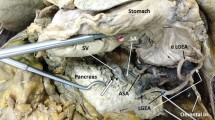Summary
The anatomic relationships of the gastroduodenal artery (GDA) and the posterior superior pancreaticoduodenal artery (PSPD) with the bile duct in their retroduodenal courses were studied in 35 bloc specimens from normal cadavers, injected after removal. The distances between the GDA, the pylorus, and the bile duct were measured in the sagittal plane. The origin and course of the PSPD in relation to the bile duct were studied. The relation of the GDA and the bile duct were divisable into four types: in Type 1 (n=22) the two structures separated progressively, the artery being on the left of the bile ducts; in Type 2: (n=7) the structures approached each other without crossing, Type 3: (n=5) the GDA crossed in front of the bile duct at the level of the first part of the duodenum (D1), Type 4: (n=1) the GDA crossed the bile duct below D1 and ran along its right border. The PSPD originated at the posterior face of D1 in 20% of cases (n=7) and crossed the anterior surface of the bile duct at the posterior surface of D1. In four cases there was no pancreatic tissue between the PSPD and the bile ducs. It follows that the risk of injury to the bile duct when securing hemostasis by transfixing a bleeding duodenal ulcer in the D1 segment is great when the arterial structures (GDA and PSPD) cross the bile duct. This risk is increased when there is no pancreatic tissue between them.
Résumé
Les auteurs ont analysé les rapports anatomiques de l'artère gastroduodénale (AGD) et de l'artère pancréatico-duodénale postérieure et supérieure (APDPS) avec le conduit cholédoque dans leur trajet rétroduodénal à partir de 35 blocs duodéno-pancréatiques sains et injectés après prélèvement. Les distances entre l'AGD, le pylore et le conduit cholédoque ont été mesurées dans le plan frontal. Les distances entre l'AGD et le conduit cholédoque ont également été mesurées dans le plan sagittal. L'origine et le trajet de l'APDPS par rapport au conduit cholédoque ont été étudiés. Les rapports de l'AGD et du conduit cholédoque ont été classés en 4 types : Type 1 (n=22) ces deux éléments s'éloignaient progressivement, l'artère se situant à gauche du conduit cholédoque; Type 2: (n=7) ils se rapprochaient sans se croiser; Type 3 : (n=5) l'AGD croisait le conduit cholédoque par en avant à la face dorsale de la partie supérieure du duodénum (D1) ; Type 4 : (n=1) l'AGD croisait le conduit cholédoque au dessus de D1 et cheminait le long de son bord droit. L'APDPS naissait à la face dorsale de D1 dans 20 % des cas (n=7) et croisait la face ventrale du conduit cholédoque à la face dorsale de D1. Dans 4 cas il n'existait pas d'interposition de tissu pancréatique entre l'APDPS et le conduit cholédoque. Il en résulte que le risque de plaie cholédocienne lors de l'hémostase d'un ulcère hémorragique de D1 par des points transfixiants est important lors d'un croisement des éléments artériels (AGD ou APDPS) et du conduit cholédoque. Ce risque est majoré en l'absence d'interposition de tissu pancréatique.
Similar content being viewed by others
References
Bertilini E, Di Gregorio F, Bertelli L, Civeli L, Mosca S (1996) The arterial blood supply of the pancreas: a review. II. The posterior superior pancreaticoduodenal artery. An anatomical and radiological study. Surg Radiol Anat 18: 1–9
Bradley RL (1973) Surgical anatomy of the gastroduodenal artery. International Surgery 58: 393–396
Daseler EH, Anson BJ, Hambley WC, Reimann AF (1947) Cystic artery and constituents of the hepatic pedicle. Surg Gynecol Obstet 85: 47
Edwards LF (1941) The retroduodenal artery. Anat Record 81: 351–355
Evrard HL (1932) Les artères du duodénum et du pancréas. Medical thesis, Paris
Flint ER (1923) Abnormalities of the right hepatic, cystic and gastroduodenal arteries, and of the bile ducts. Br J Surg 10: 509
Herrington JL, Davidson J (1987) Bleeding gastroduodenal ulcers: choise of operations. World J Surg 11: 304
Hollander LF, Marrie A, Meyer C, Begin GF, Bringer JP (1981) Les hémorragies graves des ulcères de la face postérieure du premier duodénum. Problèmes pratiques et données actuelles du traitement. A propos de 107 cas. J Chir 118: 389–393
Jordan PH, Thornby J (1987) Should it be parietal cell vagotomy of selective vagotomy — Antrectomy for treatment of duodenal ulcer? A progress report. Ann Surg 207: 572–590
Michels NA (1951) The hepatic, cystic and retroduodenal arteries and their relations to the biliary duct. Ann Surg 133: 503–524
Milon J, Milon D, Boullier A, Le Guerrier A, Lanchou G (1978) L'artère gastro-duodénale et ses variations. CR Ass Anat 62: 461–463
Shapiro AL, Robillard GL (1946) Morphology and variations of the duodenal vasculature. Arch Surg 52: 571–602
Stabile BE (1992) Current surgical management of duodenal ulcers. Surg Clin North Am 72: 335–356
Testut L, Latarjet A (1949) Traité d'anatomie humaine, tome 4. Masson, Paris
Thomson J (1933) On the arteries and ducts in the hepatic pedicle. Univ Calif Publ 1: 55–160
Weinberg JA (1961) Treatment of the massively bleeding duodenal ulcer by ligation, pyloroplasty and vagotomy. Am J Surg 102: 158–167
Welch C E, Malt R A (1987) Surgery of the stomach, duodenum, gallblader and bile ducts. N Engl J Med 316: 999–1008
Wiart P (1899) Recherche sur la forme et les rapports du pancréas. J Anat Phys pp 91–193
Author information
Authors and Affiliations
Rights and permissions
About this article
Cite this article
Prudhomme, M., Canovas, F., Godlewski, G. et al. The relationships of the bile duct and the retroduodenal arteries and their importance in the surgical treatment of hemorrhagic duodenal ulcer. Surg Radiol Anat 19, 227–230 (1997). https://doi.org/10.1007/BF01627862
Received:
Accepted:
Issue Date:
DOI: https://doi.org/10.1007/BF01627862




